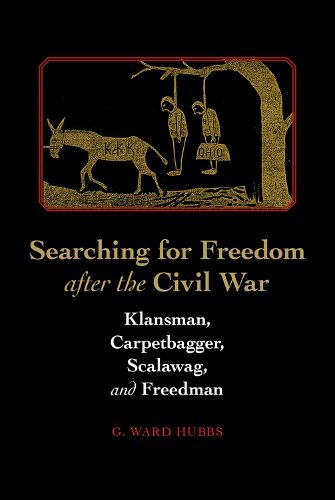Readings Newsletter
Become a Readings Member to make your shopping experience even easier.
Sign in or sign up for free!
You’re not far away from qualifying for FREE standard shipping within Australia
You’ve qualified for FREE standard shipping within Australia
The cart is loading…






Searching for Freedom after the Civil War: Klansman, Carpetbagger, Scala wag, and Freedman examines the life stories and perspectives about freedom of four figures depicted in an infamous Reconstruction-era political cartoon.
In Searching for Freedom after the Civil War: Klansman, Carpetbag ger, Scalawag, and Freedman, G. Ward Hubbs uses a stark and iconic political cartoon to illuminate post-war conflicts over the meaning of freedom in the American South.
The cartoon first appeared in the Tuskaloosa Independent Monitor, helmed by local Ku Klux Klan boss Ryland Randolph, as a swagger ing threat aimed at three individuals. Hanged from an oak branch clutching a carpetbag marked OHIO is the Reverend Arad S. Lakin, the Northern-born incoming president of the University of Alabama. Swinging from another noose is Dr. Noah B. Cloud-agricultural reformer, superintendent of education, and deemed by Randolph a scalawag for joining Alabama’s reformed state government. The accompanying caption, penned in purple prose, similarly threatens Shandy Jones, a politically active local man of colour.
Using a dynamic and unprecedented approach that interprets the same events through four points of view, Hubbs artfully unpacks nu merous layers of meaning behind this brutal two-dimensional image.
The four men associated with the cartoon-Randolph, Lakin, Cloud, and Jones-were archetypes of those who were seeking to rebuild a South shattered by war. Hubbs explores these broad archetypes but also delves deeply into the four men’s life stories, writings, speeches, and decisions in order to recreate each one’s complex worldview and quest to live freely. Their lives, but especially their four very different understandings of freedom, help to explain many of the conflicts of the 1860s. The result is an intellectual tour de force.
Scholars of the Civil War, Reconstruction, and Southern history will all consider this an important work, and general readers of this highly ac cessible volume will discover fascinating new insights about life during and after America’s greatest crisis.
$9.00 standard shipping within Australia
FREE standard shipping within Australia for orders over $100.00
Express & International shipping calculated at checkout
Searching for Freedom after the Civil War: Klansman, Carpetbagger, Scala wag, and Freedman examines the life stories and perspectives about freedom of four figures depicted in an infamous Reconstruction-era political cartoon.
In Searching for Freedom after the Civil War: Klansman, Carpetbag ger, Scalawag, and Freedman, G. Ward Hubbs uses a stark and iconic political cartoon to illuminate post-war conflicts over the meaning of freedom in the American South.
The cartoon first appeared in the Tuskaloosa Independent Monitor, helmed by local Ku Klux Klan boss Ryland Randolph, as a swagger ing threat aimed at three individuals. Hanged from an oak branch clutching a carpetbag marked OHIO is the Reverend Arad S. Lakin, the Northern-born incoming president of the University of Alabama. Swinging from another noose is Dr. Noah B. Cloud-agricultural reformer, superintendent of education, and deemed by Randolph a scalawag for joining Alabama’s reformed state government. The accompanying caption, penned in purple prose, similarly threatens Shandy Jones, a politically active local man of colour.
Using a dynamic and unprecedented approach that interprets the same events through four points of view, Hubbs artfully unpacks nu merous layers of meaning behind this brutal two-dimensional image.
The four men associated with the cartoon-Randolph, Lakin, Cloud, and Jones-were archetypes of those who were seeking to rebuild a South shattered by war. Hubbs explores these broad archetypes but also delves deeply into the four men’s life stories, writings, speeches, and decisions in order to recreate each one’s complex worldview and quest to live freely. Their lives, but especially their four very different understandings of freedom, help to explain many of the conflicts of the 1860s. The result is an intellectual tour de force.
Scholars of the Civil War, Reconstruction, and Southern history will all consider this an important work, and general readers of this highly ac cessible volume will discover fascinating new insights about life during and after America’s greatest crisis.